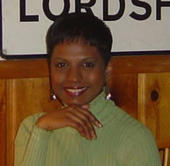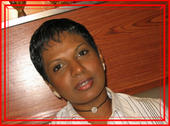Why Singapore’s English Teachers Should Embrace Singlish, Not Fight It
Is it time for Singaporean educators to embrace Singlish as a legitimate learning tool? What the Research […]
Read More
The “President’s Medal for Outstanding Graduate Student” is but one of the many awards won by Suzanna Ramos who has just returned to Singapore after completing her Master of Science Degree in Creative Studies and Change Leadership at Buffalo State College, New York. Her master’s thesis is a cross-examination of how Westerners and Easterners define creativity using implicit theories of methodology from the field of psychology.
I managed to get Suzanna Ramos away from her busy schedule at Junyuan Secondary where she has just begun her duties as Head of the Humanities Department. Her candid response to each of my questions left me wanting more.
 A: The Master of Science in Creative Studies and Change Leadership has been in existence for more than 30 years. Buffalo State College is the only institution of higher education in the world that offers this particular degree. The International Center for Studies in Creativity (ICSC) in Buffalo State College (New York) has its roots from the seminal work of Alex Osborn, who noted a need for creativity in the American education and business spheres in the 1940s. As a result, the Center for Studies in Creativity was established in 1967.
A: The Master of Science in Creative Studies and Change Leadership has been in existence for more than 30 years. Buffalo State College is the only institution of higher education in the world that offers this particular degree. The International Center for Studies in Creativity (ICSC) in Buffalo State College (New York) has its roots from the seminal work of Alex Osborn, who noted a need for creativity in the American education and business spheres in the 1940s. As a result, the Center for Studies in Creativity was established in 1967.
Basically, there are three different strands to this programme. The first deals with CPS, a creative thinking model, and Facilitation, where we learn and practise the principles and tools of creative problem solving. As creativity is a fairly new science, the second strand involves the foundation of creativity studies that incorporates various theories, approaches and literature pertaining to this field. We also learn the application of creativity principles in leadership. The third strand is about how creativity can be assessed through various measures and the literature associated with them.
 A: I have always been intrigued by the concept of creativity. I realized that as an educator, I was so caught up with the tools and techniques of creativity, which constitute only a miniscule part of this whole field. I decided to pursue this degree to get more acquainted with this field.
A: I have always been intrigued by the concept of creativity. I realized that as an educator, I was so caught up with the tools and techniques of creativity, which constitute only a miniscule part of this whole field. I decided to pursue this degree to get more acquainted with this field.
In addition to this, I was keen to learn the various creativity theories, principles and models in depth and to be able to apply them.
A: From the literature, creativity has been defined as the production of something novel and useful. These can be ideas, thoughts, actions or tangible products. In that respect, I am creative as I have been able to come up with new and useful ideas in the course of my work, studies and in other areas of my personal and professional life. So, to refer to your question, it is really thanks to this programme that I realize HOW I am creative.
A: Students come from diverse professional fields in various countries so it was wonderful to see the application of creativity principles in those areas as well as in different cultural contexts.
Secondly, the faculty has been very supportive in creating opportunities for professional dialogue and research for students so more collaborative enquiry can be carried out. The entire faculty is involved in creativity research, so it was an exciting experience to talk with them on the latest developments in the field of creativity.
In addition to this, my husband (he was also in this programme) and I facilitated various groups in creative problem solving as part of our course requirements. Two of these groups were the Bethesda World Harvest International Church, where we facilitated the senior pastor and held a leaders’ retreat for them, and the Commission on the Status of Women in Erie County where we facilitated focus groups touching on issues of women under 30 years of age. Furthermore, I made visits to middle schools in Montgomery, Alabama, to learn more about the education system there and also facilitated a group of teachers in West Valley Central on how to create interesting lessons as part of their Innovation Day.
A: Yes, definitely. I have become aware of the creative potential of students and the importance of different learning styles. The knowledge of the various theories and approaches that are research-based has made me a more informed practitioner. I am also more able to accept differing viewpoints on an issue with an open mind. All these are multifaceted aspects of the influence of studying creativity apart from simply applying creativity tools and techniques in the classroom. Since I teach Geography, I consciously structure more problem-based activities to enable my students to approach such tasks creatively and analytically.
A: I hope to demonstrate to my students and colleagues that knowledge alone cannot solve problems which are increasingly becoming heuristic in nature. In a world of growing complexity, creative thinking skills are necessary to survive in a knowledge economy. I don’t want to teach my students just Geography, but to help my students see that Geography entails certain skills which include the ability to analyse situations that require decisions to be made, to generate innovative ideas with regards to issues like ageing populations and food security, as well as to understand relationships between human and physical landscapes.
A: Yes, as long as you enable teachers to do their work more effectively, they will welcome the training. In order for creativity to be developed in the schools, teachers must be convinced that it is important. Then that training must take into consideration their working practices, time for application and reflection, and their own learning and teaching styles. Training must be in context so that teachers can experience its value first hand.
A: If you are going to get involved in creative thinking and apply it to your classroom or department in a sustainable manner, take small steps first. For example, instead of coming up with the usual list of class expectations, do it in a poem or song. Creativity involves novelty and usefulness, so this can be a simple guide. Use tools that you already have come across at workshops to help you in your own creativity. I personally like the “Idea Box” where I make random connections with words to help me look for creative ideas in my teaching. It is always good to have an “Ideas Journal” to jot down creative thoughts for teaching, as flashes of insight can occur at any time. Thus, creativity involves more than simply coming up with flashy programmes that will inevitably fizzle off.
The teacher also needs to understand that a child goes through various phases of creativity. For example, in the post-conventional phase (12 years of age to adulthood), creative thinking increasingly becomes rule-bound as critical and evaluative skills develop. The challenge for any teacher then is to enable students to produce novelty despite external constraints and conventional values.